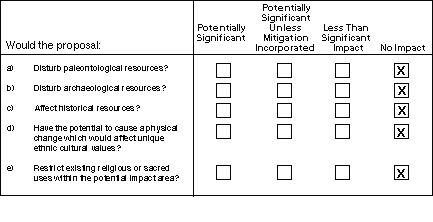
XIV. CULTURAL RESOURCES

b,c) Site reconnaissances of the substation site and power line corridors were performed by PG&E’s cultural resource specialist and an information search was performed within a half-mile radius of the project area by the Sonoma State University, Cultural Resources Study Center. The examination revealed no evidence of cultural resources in the area of the proposed project. No previous studies or recorded cultural resources sites or artifacts, other than prehistoric site CA-SCL-485 which is reported to be about 1/2 mile north of the Nortech Substation site, were revealed from the information search (PG&E, 1998 PEA). The Agnews Developmental Center West Campus, adjacent to the project, was recently listed on the National Register of Historic Places (NRHP).
Due to the potential for the site to contain cultural resources, PG&E proposes to incorporate mitigation measures into the project. The measures are as follows:
1. Work in the immediate area of the find will be halted.
2. PG&E’s archaeologists will be notified.
3. PG&E’s archaeologists will identify the find, then make the necessary plans for treatment of the find.
4. PG&E’s archaeologist will evaluate the find and if it is found to be "important" per CEQA (Appendix K), determine appropriate mitigation measures.
Because the project is proposed to incorporate the above mitigation measures, the project is not anticipated to have an effect on paleontological, archaeological, or historical resources.
d) No unique ethnic cultural values are attributed to the project site. Therefore, the project would not have an effect on ethnic cultural resources.
e) The project site is not being used for religious or sacred purposes. Therefore, the project would not have an effect on religious or sacred uses.
TOP
| Forward to Next Section (Recreation) |
Back to Previous Section (Aesthetics) |
Back to North San Jose Capacity Project Main Page | PG&E Substation Projects Main Page | CPUC Home Page |